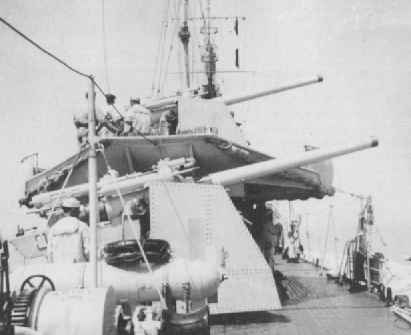The Underbuilt and overworked Spica Class Destroyer Escorts/Torpedo Boats

In order to replace their complement of out-of-date torpedo boats in the early thirties, the Regio Marina decided to build a new class of ships . Their standard displacement was limited by 600t to take advantage of limits set at the London Naval Conference of 1930 according to which the ships with displacement under 600t did not fall under limitations and could be built in any number.
According to naval shipbuilding experts, to build any vessel within the bounds of the treaty other than coastal torpedo boats, with low seaworthiness and low endurance, was impossible .
Cassiopea (one of the survivors)

For Italy, whose interests were centered on the Mediterranean with its relatively short transit distances and good weather conditions, the endurance and seaworthiness were of limited significance. The desire of the Italians was for the modernization of their torpedo fleets, rather than spending it on expensive contractual tonnage on not fully effective destroyers.
The determination to build the 600t ships had underlying political as well as economic reasons as Italy, following France’s lead, did not ratify all of the documents of the London conference and formally (if not in spirit of the treaty) had the right not to be limited by the Treaty.
Ariel's Main Battery

Antares

Alcione

Christened the Spica Class, the first two torpedo boats laid down in 1933 borrowed structural and armament layout from the Freccia class destroyer family with 100mm main guns and 450mm torpedoes. In total 32 Spica Class ships were completed differing from each other only by arrangement of torpedo banks (details were unspecified and could not be verified -Kopf). On trials Spicas exceeded 37kts, however, after full outfitting and commissioning speed was significantly decreased at the expense of design overload (880 t full ) which reduced maximum speed to 30 kts.

Successful from the point of view of an applied naval architecture project of a 600t torpedo boat , at the same time the new Class had doubtful practical value as it was intended to fulfill the majority of the operational tasks filled by destroyers in most fleets. For operations against enemy destroyers she was too small and lightly armed. For torpedo attacks on enemy surface ships , she was too large ( a good target !) and too slow, and had a side salvo of only 2-4 weak 450mm torpedoes. Ultimately due to their size and speed limits, such vessels were used for general patrol and escort duties , though in this role their anti-aircraft and anti-submarine equipment was found wanting. This led to several in-service weapon upgrades.
Nonetheless, the Spicas, despite their shortcomings, had a very busy war as their battle honours show. 23 0f the 32 in service were lost in WW2. The testimony to the overall quality of this design is in the usage of the survivors by several different navies until as late as 1964 – though with much modified armaments.
Fate of the ships of the Spica Class:
8 destroyed in air attacks
7 destroyed in ship to ship action
4 torpedoed by submarines
3 sunk by mines
1 was scuttled
9 survived
The Lupo

Specifications :
Displacement standard, t
Spica group: 638
Displacement full, t
Spica group: 885
Length, m
Spica group: 75.0 pp 80.4 oa
Breadth, m
Spica: 8.20
Draught, m
2.83 - 3.09
No of shafts
2
Machinery
Tosi geared steam turbines, 2 Yarrow boilers
Power, h. p.
19000
Max speed, knts
34
Fuel tonnage
oil : 207
Endurance, nm(kts) 1,960
Armament (originally):
3 x 1 - 100/47 OTO 1931,
2 x Twin 40mm/39 Vickers-Terni 1917 AA,
2 x 2 - 13.2/76 AAMG,
4 x 1 - 450 TT,
2 DCT,
18 - 28 mines
1941 3 x 100 mm 100/47 in A,X,Y positions ,
3 x twin 20mm 20/65 Breda 1935,
1 x twin 13.2mm 13.2/76 AAMG,
4 x 450mm torpedo tubes,
2 x Depth Charge Throwers,
18-28 mines
1942
add 2 x Depth Charge Throwers
1943
add 1 x twin 13.2 13.2/76 AAMG,
4 x 20mm 20/70 Scotti-Isotta Fraschia 1939
Sorry Guys, couldn't find any design drawings or cross sectionals
Kopfdorfer

 Author
Topic: Remembering the Spica Class Destoyer Escort (Read 5650 times)
Author
Topic: Remembering the Spica Class Destoyer Escort (Read 5650 times)


